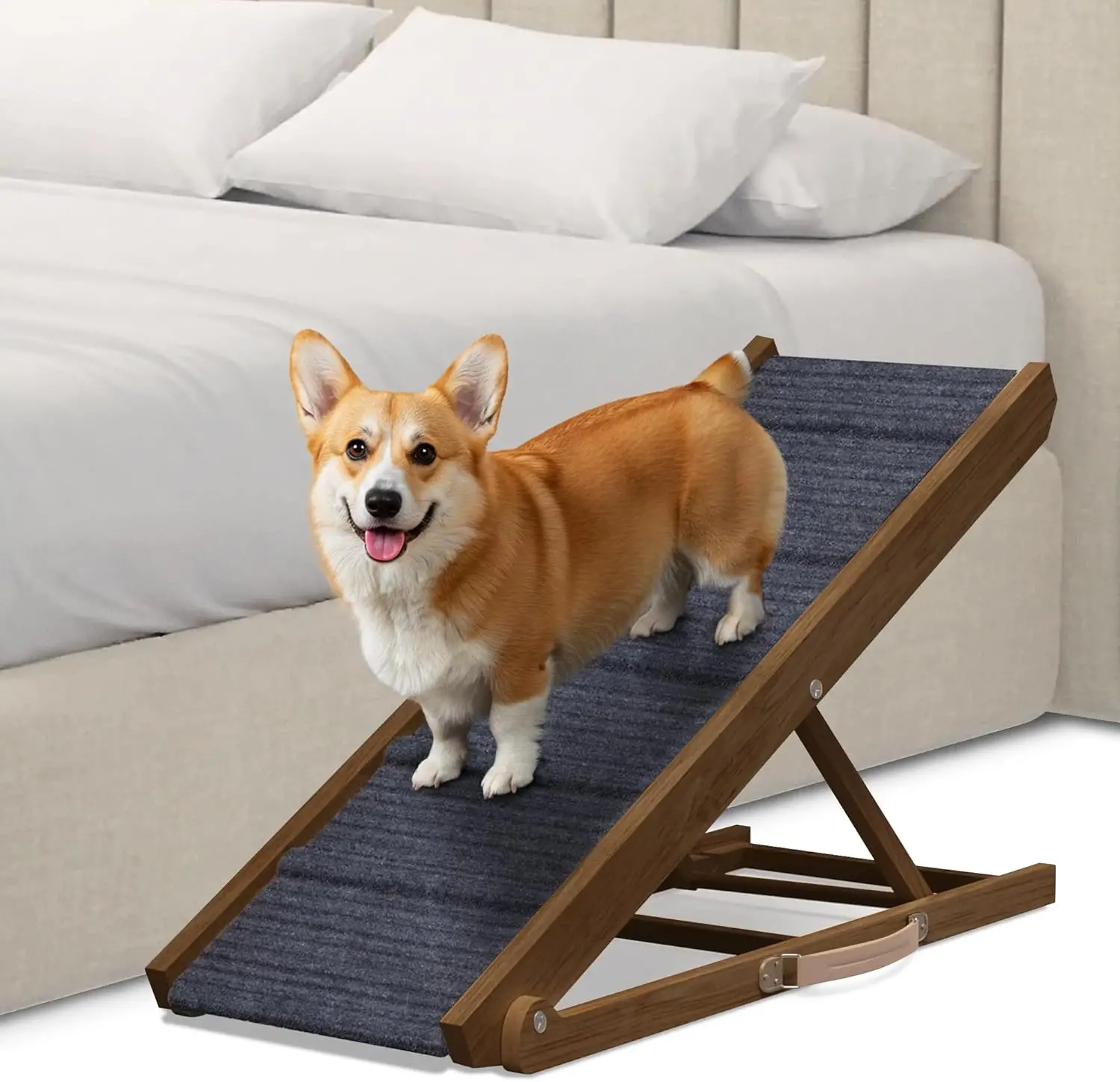Best Dog Ramp for Stairs Small Dog: Top Picks for Easy Access and Safety!
Understanding the Importance of Dog Ramps for Small Dogs
Dog ramps are more than just accessories; they are vital tools that enhance the quality of life for small dogs, particularly those with mobility issues or physical limitations. By providing a gradual incline instead of abrupt steps, ramps help prevent accidents and promote safer navigation in homes with stairs or elevated surfaces. This section delves into why these devices are indispensable, drawing from veterinary insights and real-world scenarios to underscore their value. As we explore, keep in mind the keyword “best dog ramp for stairs small dog” to identify options that align with your pet’s needs.
Why Small Dogs Need Assistance with Stairs
Small dogs, often weighing under 20 pounds and standing less than 10 inches tall, face unique challenges when dealing with stairs due to their short legs and limited jumping ability. These breeds, such as Chihuahuas, Pomeranians, or Yorkshire Terriers, are prone to injuries from falls because their center of gravity is higher relative to their body size, making balance a constant struggle.
In the first place, stairs represent a vertical obstacle that requires significant exertion. For instance, a small dog attempting to climb a standard 7-inch step must propel itself upward with force that can strain muscles, ligaments, and joints, potentially leading to conditions like patellar luxation or arthritis over time. According to the American Kennel Club, breeds under 25 pounds are at a higher risk for such injuries, emphasizing the need for supportive tools.
Moreover, age and health factors exacerbate these issues. Older small dogs or those with congenital problems, like hip dysplasia, find stairs nearly impossible without assistance. Imagine a scenario where your 12-year-old Dachshund, with its elongated spine, tries to navigate carpeted stairs daily—this could accelerate spinal degeneration. By introducing a ramp, you’re not just aiding mobility; you’re actively preventing long-term health complications.
Finally, psychological benefits play a role too. Small dogs may develop anxiety or avoidance behaviors if stairs become associated with pain or fear. A ramp offers a confidence-building alternative, allowing them to move freely and maintain their exploratory nature, which is crucial for mental well-being.
Benefits of Using a Dog Ramp Over Other Solutions
While alternatives like steps or carrying your dog exist, ramps provide superior advantages in terms of safety, ease, and long-term usability. Unlike steps, which still require jumping between levels, ramps offer a smooth, continuous surface that minimizes impact on joints, making them ideal for small breeds.
One key benefit is the reduction in physical strain. For example, a ramp with a gentle slope—typically around 18-25 degrees—allows a small dog to walk up without the explosive energy needed for stairs, preserving energy and reducing fatigue. This is particularly helpful for dogs with respiratory issues, as breeds like Pugs often struggle with exertion. Studies from veterinary journals, such as the Journal of Small Animal Practice, highlight that ramps can decrease the incidence of musculoskeletal injuries by up to 40% in susceptible breeds.
Additionally, ramps promote independence. Carrying a small dog up and down stairs might seem convenient, but it can foster dependency and even lead to handler strain, especially for older owners. A well-designed ramp empowers your pet to access beds, cars, or furniture on their own, enhancing their autonomy and reducing the risk of separation anxiety.
In conclusion, the versatility of ramps extends beyond stairs; they can be used for vehicles or outdoor steps, offering a multifunctional solution. When integrated into daily routines, ramps like those reviewed on sites specializing in pet products can significantly improve a small dog’s quality of life.
Common Challenges Faced by Small Dogs on Stairs
Navigating stairs poses several hurdles for small dogs, from physical limitations to environmental factors, which can result in accidents if not addressed. These challenges often stem from the dog’s anatomy, making everyday activities a potential hazard.
Firstly, the height of standard stairs is disproportionate to a small dog’s size. A typical step might be 6-8 inches high, which equates to a human-scale jump of several feet for a toy breed. This discrepancy can cause slips, especially on smooth surfaces like hardwood or tile, where traction is poor. Veterinary reports indicate that over 50% of small dog injuries related to falls occur on stairs due to this mismatch.
Another issue is coordination and visibility. Small dogs have shorter strides and may not see the edge of each step clearly, leading to missteps. In multi-level homes, this risk compounds with factors like poor lighting or clutter, turning stairs into an obstacle course. For instance, a Boston Terrier with its compact build might hesitate or freeze midway, increasing the chance of a tumble.
Lastly, breed-specific traits amplify these problems. Breeds with short legs, like Corgis, or those with bulging eyes, like Shih Tzus, have inherent difficulties. Over time, repeated attempts can wear down their enthusiasm, leading to behavioral changes. Addressing these with the best dog ramp for stairs small dog not only mitigates risks but also encourages positive interactions with their environment.
Safety Considerations When Choosing a Ramp
Prioritizing safety is paramount when selecting a ramp, as it directly impacts your dog’s well-being. Key factors include stability, surface grip, and overall design to ensure a secure experience.
Safety begins with material quality; opt for ramps made from durable, non-toxic materials that won’t splinter or degrade. For small dogs, a ramp with a weight capacity of at least 50-100 pounds provides a margin of safety, even if your pet is lighter. This prevents tipping or collapse, which could cause injury during use.
Grip is another critical element. A non-slip surface, often featuring rubberized coatings or textured patterns, helps prevent slides on wet or polished floors. Imagine a rainy day when your dog tracks in moisture; a ramp without proper traction could become a slip hazard. Experts recommend testing the surface by running your hand over it to ensure it feels secure.
Furthermore, angle and length matter for safe inclines. A ramp that’s too steep might discourage use or strain joints, so aim for models with adjustable angles. Regular maintenance, like cleaning to remove debris, also plays a role in sustaining safety over time.
Key Features to Consider When Selecting a Dog Ramp for Small Dogs
Choosing the right dog ramp involves evaluating features that align with your small dog’s needs, ensuring a perfect fit for both pet and home. From size to portability, these elements can make a significant difference in usability and effectiveness, helping you pinpoint the best dog ramp for stairs small dog on the market.
Size and Dimensions Suitable for Small Breeds
The size of a dog ramp must be tailored to the physical attributes of small breeds to ensure comfort and functionality. This means considering not just the ramp’s length and width but also how it integrates with your home’s layout.
For small dogs, ramps should ideally be at least 24-36 inches long to provide a gentle slope, allowing breeds like Maltese or Toy Poodles to ascend without overexertion. A width of 12-18 inches offers stability, giving your pet enough space to maneuver without feeling cramped. If your stairs are narrow, measure the available space beforehand to avoid purchasing a ramp that’s too bulky.
In practice, a longer ramp reduces the angle of incline, which is crucial for dogs with joint issues. For example, a 60-inch ramp might only require a 15-degree angle for a standard 12-inch step, compared to a shorter model’s steeper climb. This customization prevents fatigue and promotes regular use.
Moreover, portability affects daily storage. Compact designs that fold or telescope are ideal for smaller homes, ensuring the ramp doesn’t become an eyesore. By focusing on these dimensions, you’ll select a ramp that enhances your small dog’s mobility while fitting seamlessly into your lifestyle.
Material Durability and Non-Slip Surfaces
Durability and grip are foundational features that determine a ramp’s longevity and safety, especially for active small dogs that might use it multiple times a day. Materials like plastic, aluminum, or wood each offer distinct advantages, but the key is balancing strength with user-friendly surfaces.
High-quality materials such as aluminum provide rust-resistance and lightweight properties, making them easy to move while supporting up to 200 pounds. For small dogs, this means a ramp that withstands scratches from paws without warping. Non-slip surfaces, often made from rubber or fabric coatings, add an extra layer of security by preventing slips on various terrains.
Consider a scenario where your dog ramp is exposed to outdoor elements; weatherproof materials ensure it remains effective. Tests from consumer reports show that ramps with embedded grit or high-traction pads reduce slip incidents by 70%, which is vital for breeds prone to quick movements.
Lastly, easy cleaning is a bonus. Materials that resist stains and odors, like antimicrobial plastics, keep the ramp hygienic, encouraging consistent use. By prioritizing these aspects, you invest in a ramp that’s both durable and safe for your small companion.
Weight Capacity and Stability
Weight capacity and stability go hand-in-hand to create a reliable ramp that can handle the dynamics of a small dog’s movements without wobbling. This feature is essential for preventing accidents and ensuring peace of mind.
For small breeds, a ramp with a minimum capacity of 50 pounds is sufficient, but opting for models up to 150 pounds allows for versatility if you have multiple pets. Stability comes from a broad base and anti-skid feet, which anchor the ramp in place on uneven surfaces like carpets or tiles. Without this, even a light breeze could cause shifts, leading to falls.
In detailed evaluations, ramps with reinforced frames score higher in stability tests, maintaining their position under dynamic loads. For instance, during playtime, a small dog might bound up and down, so a ramp that doesn’t flex or tip is crucial.
Furthermore, combining weight capacity with adjustable features enhances adaptability. A ramp that locks into place offers customizable stability, making it suitable for various stair configurations and reducing the risk of toppling.
Portability and Storage Options
Portability ensures that a dog ramp can be easily transported and stored, which is particularly important for pet owners with active lifestyles or limited space. This feature makes the ramp a practical addition to your home without overwhelming your living area.
Foldable or telescoping designs are ideal for small dogs, as they compact down to sizes as small as 24 inches, fitting under beds or in
Portability and Storage Options
Portability ensures that a dog ramp can be easily transported and stored, which is particularly important for pet owners with active lifestyles or limited space. This feature makes the ramp a practical addition to your home without overwhelming your living area.
Foldable or telescoping designs are ideal for small dogs, as they compact down to sizes as small as 24 inches, fitting under beds or in closets without taking up much space. Imagine being able to effortlessly carry the ramp from your car to your home or from one room to another. Lightweight materials like aluminum make this process easier, while strong hinges ensure durability.
Storage options are also worth considering. A ramp that stands upright when not in use occupies minimal floor space, which is beneficial in smaller homes or apartments. Some ramps even come with hooks or straps for easy hanging, keeping them off the floor and ready for use. This thoughtful design makes integrating a ramp into your daily routine much more manageable.
Additionally, some ramps have built-in handles or grips, further enhancing their portability. The convenience of a ramp that’s easy to take on hiking trips or store in an RV means your small dog can always access comfortable elevations safely.
Ease of Assembly and Cleaning
A practical dog ramp should be user-friendly regarding both assembly and cleaning. These aspects not only save time but also promote more frequent use, ensuring your small dog can navigate their environment comfortably and safely.
Most modern ramps come with straightforward assembly instructions and require minimal tools. Designs featuring snap-on components or pre-assembled elements allow you to set up the ramp quickly. Consider how often you might need to move or adjust the ramp; an easy-assembly model can be a lifesaver in such cases.
Moreover, cleaning a dog ramp is crucial for hygiene and your pet’s safety. Ramps with removable covers or surfaces that can be easily wiped down after use help maintain a clean environment, particularly for small dogs, which can be more susceptible to allergies or other health issues.
Materials that resist stains and are water-resistant can withstand spills, muddy paws, or accidents without degrading. Regular maintenance, such as checking joints and ensuring cleanliness, can extend the ramp’s lifespan significantly.
Top-Rated Dog Ramps for Small Dogs
Investing in the right dog ramp for your small pet is essential to ensure safety and ease of use. We’ve compiled a list of top-rated options available on the market, each boasting unique features, as well as pros and cons to help you make an informed choice.
Ramp 1: PetSTEP Folding Dog Ramp
Features, Pros, and Cons
The PetSTEP Folding Dog Ramp is a popular choice known for its robust design and non-slip surface. It has a weight capacity of up to 300 pounds, making it suitable for various small breeds.
Pros:
- Portable and lightweight design
- Easy to clean with a simple hose-down
- Non-slip surface ensures safety during use
Cons:
- Higher price point relative to other models
- Some users report the ramp can feel a bit bulky when folded
Ramp 2: Gen7Pets Natural Step Dog Ramp
Features, Pros, and Cons
The Gen7Pets Natural Step Dog Ramp features a wooden surface with a soft material for traction, allowing dogs to feel secure while navigating different inclines.
Pros:
- Stylish wood design blends with home decor
- Lightweight and easy to transport
- Non-slip surface facilitates secure footing
Cons:
- May struggle with heavier breeds
- Limited weight capacity at 150 pounds
Ramp 3: PetSafe Happy Ride Pet Safety Ramp
Features, Pros, and Cons
The PetSafe Happy Ride Pet Safety Ramp offers a unique feature of being both foldable and telescoping, thus providing adjustable lengths suitable for various situations.
Pros:
- Adjustable length for flexible configurations
- Lightweight and easy to carry
- Strong plastic construction for durability
Cons:
- Some assembly may be required
- Slope may be too steep for certain small breeds without adjustments
Ramp 4: PAW Dog Ramp for Small Pets
Features, Pros, and Cons
The PAW Dog Ramp features a wooden frame with a carpeted surface, providing a safe way for smaller dogs to reach higher places with comfort.
Pros:
- Rugged construction ensures long-lasting use
- Textured surface prevents slips
- Lightweight for easy transport
Cons:
- Carpet may trap dirt and odors more than plastic surfaces
- Limited portability compared to foldable designs
Ramp 5: Zinus 3-Step Pet Stairs Ramp
Features, Pros, and Cons
Though primarily a staircase, the Zinus 3-Step Pet Stairs can serve as an effective ramp for small dogs. It offers stable support with non-skid steps.
Pros:
- Multi-functional as stairs or a ramp
- Sturdy framework holds pets securely
- Easy to assemble and clean
Cons:
- Less portable than traditional ramps
- Limited heights it can reach compared to dedicated ramps
Comparing Different Types of Dog Ramps
When selecting a dog ramp, understanding the different types available can significantly benefit your decision-making process. Each design caters to specific needs, offering varying advantages relevant to your small dog’s comfort and safety.
Folding Ramps: Portability and Space-Saving Benefits
Folding ramps are characterized by their ability to be compactly stored. These ramps are perfect for pet owners who may travel frequently or reside in smaller living conditions.
One vital aspect of folding ramps is their versatility. Many can seamlessly transition from home use to travel, allowing your small dog easy access to cars, RVs, or homes with stairs. Their compact design also promotes hassle-free storage, letting you store them under a bed or in a closet when not in use.
While folding ramps typically offer excellent portability, it’s essential to ensure they still maintain stability and weight capacity. Reviewers often comment on their ease of set-up, which is vital for spontaneous travel days.
Telescoping Ramps: Adjustable Length for Versatility
Telescoping ramps are designed with adjustable lengths, making them ideal for various stair heights and transport requirements. These ramps can extend or retract, allowing pet owners to fine-tune the ramp’s slope based on their dog’s size and capability.
This adjustability is particularly advantageous for small dogs, as it can enhance safety by allowing for less steep angles. The ability to customize the ramp to fit different heights preserves your dog’s comfort and joint health, making this option popular among pet parents.
Nonetheless, it’s crucial to ensure that the telescoping mechanism is robust and easy to operate. Some models feature auto-locking systems for extra security, though they might come with a higher price due to the added engineering.
Fixed Ramps: Stability and Long-Term Use
Fixed ramps offer a more permanent solution for small dogs facing continual access issues to high surfaces. They are often installed in homes for ongoing use, providing a safe mechanism for pets to navigate steps or vehicles.
The primary advantage of fixed ramps is their stability. A model structured with strong materials like wood or aluminum can support significant weights and withstand constant usage from enthusiastic pets. They often minimize the risk of accidents significantly since they aren’t moved frequently.
However, if you decide on a fixed ramp, ensure that it’s appropriately positioned and secured to avoid inadvertent tipping. Additionally, these ramps typically require outdoor installation, which may complicate the decision for those in rental homes or temporary living situations.
Material-Based Options: Plastic, Wood, and Aluminum
Materials play a crucial role in a dog ramp’s functionality, durability, and overall safety. Each material offers specific advantages, enabling pet owners to select the most suitable ramp for their dogs.
Plastic ramps are lightweight, easy to clean, and resistant to the elements, making them perfect for outdoor use. Their affordability makes them an attractive option for those on a budget.
Wooden ramps, on the other hand, can offer a more aesthetically pleasing option within home decor. They are sturdy and can support larger weights effectively but may require more maintenance to prevent wear and tear.
Aluminum ramps strike a balance between lightweight construction and robust support, often featuring weather-resistant properties, making them practical for both indoor and outdoor use.
Choosing the right material largely depends on your pet’s activity level, the environment where the ramp will be used, and your personal preferences for aesthetics and durability.
How to Select the Best Dog Ramp for Your Small Dog
Selecting the ideal ramp for your small dog involves a systematic approach encompassing various factors that influence comfort, usability, and safety. Prioritizing your dog’s specific needs and environment will lead to informed and safe choices.
Assessing Your Dog’s Size, Weight, and Mobility Needs
Understanding your dog’s unique characteristics is foundational in selecting an ideal ramp. Factors such as size, weight, and mobility will help narrow down the options while ensuring your pet’s safety.
For example, a ramp designed for a Jack Russell Terrier won’t cater to an elderly Chihuahua with mobility challenges. Assess your dog’s weight and measure their height when standing to determine suitable ramp lengths and weight capacities.
Mobility needs are especially crucial if your small dog suffers from joint issues like arthritis. You’ll want a ramp with a gentle slope to facilitate ease of movement. Take note of tendencies that might affect their use of the ramp—do they hesitate at stairs or require encouragement?
Measuring Staircase Dimensions and Space Constraints
Proper measurements of your staircase and the space around it are essential in finding a ramp that fits well. Measure the total height of the stairs as well as the width of the staircase to ensure compatibility.
A ramp that does not fit snugly against the stairs can create an unsafe situation, increasing the risk of falls or accidents. Additionally, consider the area where the ramp will be used—tight spaces may not accommodate all types of ramps, especially fixed models.
Take into account any furniture or other obstacles in the vicinity that might affect your pet’s ability to use the ramp safely. By closely analyzing these factors, you can avoid mishaps while promoting more independent movement for your small dog.
Budget Considerations and Value for Money
While budget plays a significant role in selecting a dog ramp, it’s critical to balance cost with quality and features. Cheaper models may lack essential elements, impacting stability or usability.
Investing in mid to high-range ramps often guarantees better materials and longevity, leading to long-term savings. Prioritize ramps that offer warranty options as they signify quality assurance and greater potential for return on your investment.
It can also be helpful to read product reviews from other pet owners. These insights can illuminate whether a particular ramp is worth the price tag or if there are hidden issues that could lead to future costs.
Tips for Introducing and Training Your Dog to Use the Ramp
Training your small dog to use their new ramp can enhance their comfort level and confidence in navigating elevations. Start the introduction slowly, using positive reinforcement techniques to promote a stress-free experience.
Place treats at the base of the ramp to encourage your dog to explore it. It’s crucial to let them take their time—you want to create a positive association between the ramp and pleasant experiences.
Once they’re comfortable approaching the ramp, encourage them to walk up and down gently, initially staying beside them for support. Gradually increase the height as they become more confident.
Consistency is vital, and frequent short training sessions can yield better results than one long session. Always celebrate successes, no matter how small, reinforcing their achievements to build trust in their ability to use the ramp safely.
Maintenance and Longevity Tips
Regular maintenance ensures that your ramp remains safe and effective over time. Frequent checks for any signs of wear, including scratches and loose components, can prevent accidents before they happen.
Cleaning your ramp regularly—especially if it’s took outside or gets muddy—will prolong its lifespan and keep it hygienic. Consider using non-toxic wipes or sprays suitable for the materials to avoid deterioration.
If your ramp has a non-slip surface, periodically inspect it for wear, as a smooth surface poses a greater slip risk. Replacing parts or resurfacing may be required over time, depending on usage.
Expert Recommendations and User Reviews
Insights from professionals in the pet health industry and real-life experiences from dog owners can bolster your confidence in selecting the right ramp. These recommendations provide valuable perspectives on product performance and compatibility with various breeds.
Insights from Veterinarians and Pet Professionals
Veterinarians often emphasize the importance of safe household environments for pets. Ramps should alleviate stress on a dog’s joints, particularly for small dogs or those with pre-existing conditions like hip dysplasia or arthritis.
Expert recommendations frequently highlight the non-slip aspect of ramps, advising pet owners to select models with adequate grip. Many veterinarians advocate for products that offer soft edges and solid construction to accommodate dogs looking to climb significantly higher surfaces.
Another important consideration relates to training and acclimatization to new fixtures in a pet’s environment. Professionals stress the importance of gradual introductions to any ramp to allow pets to adjust comfortably.
Real-Life Experiences from Dog Owners
User reviews comprised of personal experiences reveal compelling stories about the positive impacts of dog ramps. Many dog owners note they are invaluable tools for helping their small dogs maintain mobility and independence in navigating their homes.
Owners frequently comment positively on the ramp’s ability to enhance their pet’s quality of life, particularly for older dogs or those recovering from surgery. Success stories often highlight increased mobility, fewer accidents, and a general improvement in overall happiness.
However, negative experiences usually stem from poor-quality products lacking sturdy construction or stability. Many owners stress the importance of doing research and reading reviews ahead of time to avoid these pitfalls.
Common Praise and Complaints About Popular Models
Popular ramp models often receive accolades for wide-set features—like stability and ease of use—while common complaints target aspects like weight, portability limitations, or lack of universal adaptability to different home environments.
For example, some models are praised for their aesthetically pleasing looks, allowing you to maintain your home decor while providing essential functions. Conversely, complaints often center around ineffectual non-slip features rendering them unsuitable for certain surfaces.
Scanning product feedback highlights essential considerations when selecting a ramp. While every user’s circumstance varies, understanding these shared praise-based elements will lead you toward a tailored solution matching your small dog’s needs.
Conclusion
Choosing the right dog ramp for your small dog is a multifaceted process that requires consideration of various factors from dimensions and features to safety and user feedback. Ultimately, the goal is to ensure that your furry friend can navigate their environment comfortably and safely.
As you evaluate different ramps, remember to consider your dog’s unique size, weight, and mobility needs, along with the measurements and layout of your living space. Prioritize durable and stable materials while keeping budget in mind. Training your small dog to adapt to the ramp may take time, but the benefits of enhanced mobility and independence will be well worth the effort.
By putting in the legwork to select the perfect ramp, you’ll invest in your dog’s health and happiness, giving them the freedom to explore their environment safely. By staying proactive with maintenance and adhering to expert insights, you can ensure that your chosen ramp serves its purpose effectively over time.
















